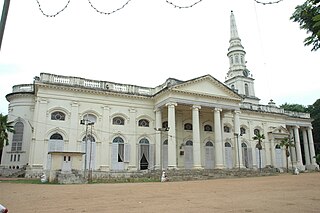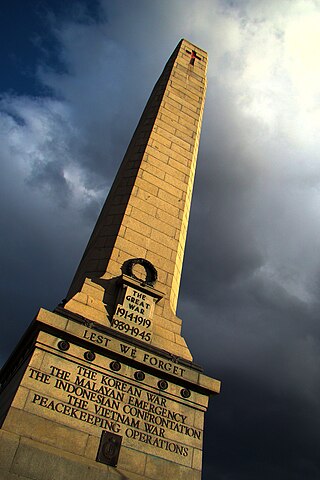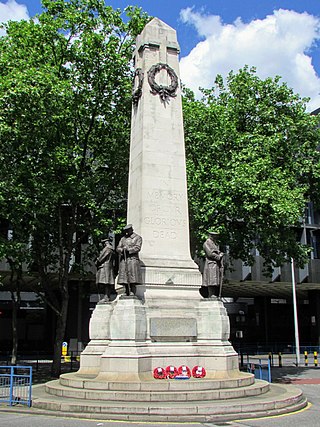
Marina Beach, or simply the Marina, is a natural urban beach in Chennai, Tamil Nadu, India, along the Bay of Bengal. The beach runs from near Fort St. George in the north to Foreshore Estate in the south, a distance of 6.0 km (3.7 mi), making it the second longest urban beach in the world, after Cox's Bazar Beach. It is a prominent landmark in Chennai.

The Indian Army during British rule, also referred to as the British Indian Army, was the main military force of India until national independence in 1947. Formed in 1895 by uniting the three Presidency armies, it was responsible for the defence of both British India and the princely states, which could also have their own armies. As stated in the Imperial Gazetteer of India, the "British Government has undertaken to protect the dominions of the Native princes from invasion and even from rebellion within: its army is organized for the defence not merely of British India, but of all possessions under the suzerainty of the King-Emperor." The Indian Army was a vital part of the British Empire's military forces, especially in World War I and World War II.

The Madras Presidency or Madras State, officially called the Presidency of Fort St. George until 1937, was an administrative subdivision (state) of British Raj and later the Republic of India. At its greatest extent, the presidency included most of southern India, including all of present-day Andhra Pradesh, almost all of Tamil Nadu and parts of Kerala, Karnataka, Odisha and Telangana in the modern day. The city of Madras was the winter capital of the presidency and Ooty (Udagamandalam) was the summer capital.

Chennai, formerly known as Madras, is the capital of the state of Tamil Nadu and is India's fifth largest city. It is located on the Coromandel Coast of the Bay of Bengal. With an estimated population of 12.05 million (2024), the 383-year-old city is the 31st largest metropolitan area in the world.

Saint Mary Church of Chennai, constructed in 1712 and reconstructed in 1772, is one of the oldest churches of the Indian subcontinent, located in Chennai. It is famous for its belfry of six. The Church, also called the Armenian Church of Virgin Mary, is located on the Armenian Street in the neighbourhood of George Town.

Minjur Bhakthavatsalam was an Indian independence activist and politician who served as the chief minister of Madras State from 2 October 1963 to 6 March 1967. He was the last Congress chief minister of Tamil Nadu and the last to have taken part in the Indian independence movement.
The Madras Presidency Match was an annual first-class cricket fixture played in Madras from the 1915–16 season to 1951–52 between teams called the Indians and the Europeans. The matches were played in the Chepauk Grounds usually in mid-January around the time of Pongal festival, and the fixture was sometimes called the Pongal match. Of the 37 matches played, 33 were first-class and the Indians won 15 of those, the Europeans eight and ten were drawn.

St. George's Cathedral is a Church of South India cathedral in Chennai, India. The cathedral was built in 1815. St. George's occupies an important place in the history of Christianity in India, as the Church of South India was inaugurated here on 27 September 1947. It marked the breaking down of ecclesiastical barriers between Protestants of various traditions.

Hobart Cenotaph is the main commemorative military monument for the Australian state of Tasmania. It is located in the capital Hobart in a prominent position on the Queens Domain, on a small rise overlooking the city and River Derwent. The Cenotaph sits directly above what was once the location of the Queens Battery.

The Royal Air Force Memorial is a military memorial on the Victoria Embankment in central London, dedicated to the memory of the casualties of the Royal Air Force in World War I. Unveiled in 1923, it became a Grade II listed structure in 1958, and was upgraded to Grade II* in 2018. It is considered to be the official memorial of the RAF and related services.

Madras War Cemetery is located in Nandambakkam, Chennai, Tamil Nadu, India. It was created to receive Second World War graves from civil and cantonment cemeteries in the south and east of India where their permanent maintenance could not be assured.

The Battle of Koregaon was fought on 1 January 1818 between the British East India Company and the Peshwa faction of the Maratha Confederacy, at Koregaon Bhima.

A. Vaidyanatha Iyer, also known as Madurai Vaidyanatha Iyer or Ayyar was an Indian activist, politician and freedom-fighter who spearheaded the temple entry movement in Madras Presidency in 1939.

M. Muhammad Ismail was an Indian politician and social worker from southern Indian state Tamil Nadu. he was a founder of the Indian Union Muslim League party after the partition of British India. He was popularly known in Tamil Nadu and Kerala as the "Quaid-e-Millat". Ismail was a member of Madras Legislative Assembly and Leader of the Opposition (1946—52). He was also a member (1948—50) of the Constituent Assembly, the drafting body of the constitution of India. He was also a member of Rajya Sabha (1952—58) and Lok Sabha.

Cinema of South India, refers to the cinema of the four major film industries in South India; primarily engaged in making feature films in the four major languages of the region, namely — Telugu, Tamil, Kannada and Malayalam. They are often colloquially referred to as Tollywood, Kollywood, Sandalwood and Mollywood, respectively.

Southport War Memorial is in London Square, Lord Street, Southport, Merseyside, England. It consists of an obelisk flanked by two colonnades in the form of Greek temples. Outside the colonnades are memorial gardens, each containing a Pool of Remembrance and fountains. The memorial was designed by the local architects Grayson and Barnish, and the carving was executed by Herbert Tyson Smith. It was unveiled in 1923 by the Earl of Derby. Following the Second World War and subsequent conflicts further inscriptions and names have been added. The memorial is recorded in the National Heritage List for England as a designated Grade II* listed building.

The Guards Memorial, also known as the Guards Division War Memorial, is an outdoor war memorial located on the west side of Horse Guards Road, opposite Horse Guards Parade in London, United Kingdom. It commemorates the war dead from the Guards Division and related units during the First World War, and of the Household Division in the Second World War and other conflicts since 1918.

Lewes War Memorial is a war memorial at the top of School Hill in the centre of Lewes in East Sussex, prominently sited at the junction of High Street and Market Street. It commemorates 251 men from Lewes who died in the First World War, and 126 who died in the Second World War. It was unveiled in 1922 and became a listed building in 1985.

The London and North Western Railway War Memorial is a First World War memorial located outside Euston station in London, England. The memorial was designed by Reginald Wynn Owen, architect to the London and North Western Railway (LNWR), and commemorates employees of the LNWR who were killed in the First World War. Some 37,000 LNWR employees left to fight in the war—around a third of the company's workforce—of whom over 3,000 were killed. As well as personnel, much of the company's infrastructure was turned over to the war effort. Of the £12,500 cost of the memorial, £4,000 was contributed by the employees and the company paid the remainder.

The High Court of Judicature at Madras is a High Court located in Chennai, India. It has appellate jurisdiction over the state of Tamil Nadu and the union territory of Puducherry. It is one of the oldest high courts of India along with Calcutta High Court in Kolkata and Bombay High Court in Mumbai. The Madras High Court is one of four charter high courts of colonial India established in the four Presidency Towns of Madras, Bombay, Allahabad and Calcutta by letters patent granted by Queen Victoria, dated 26 June 1862. It exercises original jurisdiction over the city of Chennai, as well as extraordinary original jurisdiction, civil and criminal, under the letters patent and special original jurisdiction for the issue of writs under the Constitution of India. Covering 107 acres, the court complex is one of the largest in the world, second only to the Supreme Court of the United Kingdom. The four-storey administrative building serves hundreds of litigants every day.




















